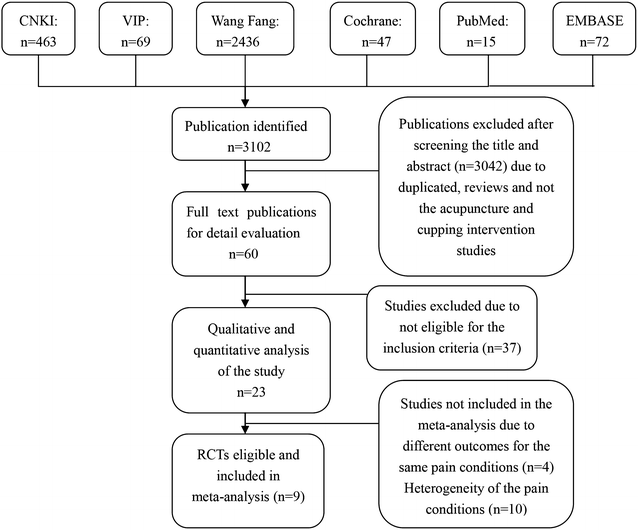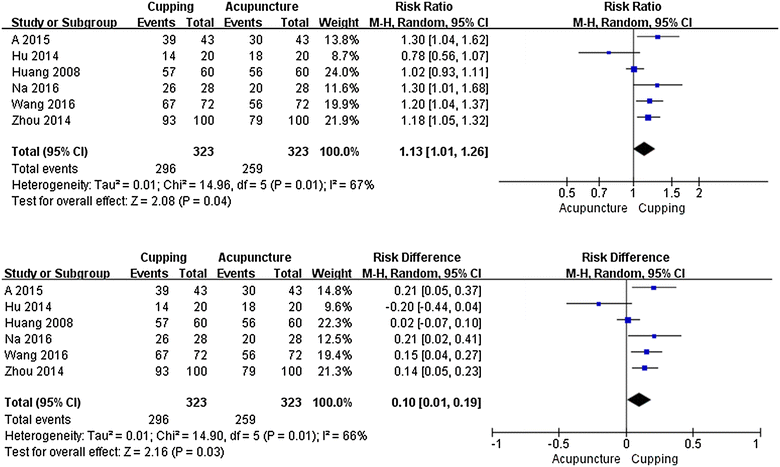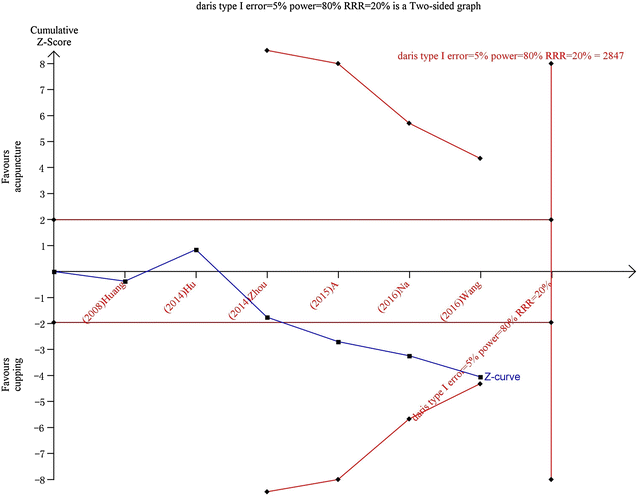Cupping therapy versus acupuncture for pain-related conditions: a systematic review of randomized controlled trials and trial sequential analysis
- PMID: 28770000
- PMCID: PMC5525375
- DOI: 10.1186/s13020-017-0142-0
Cupping therapy versus acupuncture for pain-related conditions: a systematic review of randomized controlled trials and trial sequential analysis
Abstract
Background: Both cupping therapy and acupuncture have been used in China for a long time, and their target indications are pain-related conditions. There is no systematic review comparing the effectiveness of these two therapies.
Objectives: To compare the beneficial effectiveness and safety between cupping therapy and acupuncture for pain-related conditions to provide evidence for clinical practice.
Methods: Protocol of this review was registered in PROSPERO (CRD42016050986). We conducted literature search from six electronic databases until 31st March 2017. We included randomized trials comparing cupping therapy with acupuncture on pain-related conditions. Methodological quality of the included studies was evaluated by risk of bias tool. Mean difference, risk ratio, risk difference and their 95% confidence interval were used to report the estimate effect of the pooled results through meta-analysis or the results from each individual study. Trial sequential analysis (TSA) was applied to adjust random errors and calculate the sample size.
Results: Twenty-three randomized trials with 2845 participants were included covering 12 pain-related conditions. All included studies were of poor methodological quality. Three meta-analyses were conducted, which showed similar clinical beneficial effects of cupping therapy and acupuncture for the rate of symptom improvement in cervical spondylosis (RR 1.13, 95% CI 1.01 to 1.26; n = 646), lateral femoral cutaneous neuritis (RR 1.10, 95% CI 1.00 to 1.22; n = 102) and scapulohumeral periarthritis (RR 1.31, 95% CI 1.15 to 1.51; n = 208). Results from other outcomes (such as visual analogue and numerical rating scale) in each study also showed no statistical significant difference between these two therapies for all included pain-related conditions. The results of TSA for cervical spondylosis demonstrated that the current available data have not reached a powerful conclusion. No serious adverse events related to cupping therapy or acupuncture was found in included studies.
Conclusion: Cupping therapy and acupuncture are potentially safe, and they have similar effectiveness in relieving pain. However, further rigorous studies investigating relevant pain-related conditions are warranted to establish comparative effectiveness analysis between these two therapies. Cost-effectiveness studies should be considered in the future studies to establish evidence for decision-making in clinical practice.
Keywords: Acupuncture; Cupping therapy; Randomized controlled trial; Systematic review; Trial sequential analysis.
Figures




Similar articles
-
Cupping therapy for patients with chronic urticaria: A systematic review and meta-analysis.J Integr Med. 2020 Jul;18(4):303-312. doi: 10.1016/j.joim.2020.05.004. Epub 2020 May 28. J Integr Med. 2020. PMID: 32534938
-
Update evidence of effectiveness on pain relieving of cupping therapy: a systematic review and Meta-analysis of randomized controlled trials.J Tradit Chin Med. 2025 Apr;45(2):234-253. doi: 10.19852/j.cnki.jtcm.2025.02.002. J Tradit Chin Med. 2025. PMID: 40151111 Free PMC article.
-
Acupuncture for Primary Insomnia: An Updated Systematic Review of Randomized Controlled Trials.J Altern Complement Med. 2019 May;25(5):451-474. doi: 10.1089/acm.2018.0046. Epub 2019 Apr 23. J Altern Complement Med. 2019. PMID: 31013432
-
Efficacy and safety of wet cupping in the treatment of neurodermatitis: a systematic review and meta-analysis.Front Med (Lausanne). 2024 Dec 19;11:1478073. doi: 10.3389/fmed.2024.1478073. eCollection 2024. Front Med (Lausanne). 2024. PMID: 39748922 Free PMC article. Review.
-
Cochrane Review: Osmotic and stimulant laxatives for the management of childhood constipation (Review).Evid Based Child Health. 2013 Jan;8(1):57-109. doi: 10.1002/ebch.1893. Evid Based Child Health. 2013. PMID: 23878124 Review.
Cited by
-
Acupuncture for mild cognitive impairment: A systematic review with meta-analysis and trial sequential analysis.Front Neurol. 2023 Jan 6;13:1091125. doi: 10.3389/fneur.2022.1091125. eCollection 2022. Front Neurol. 2023. PMID: 36686535 Free PMC article.
-
Efficacy of Moxibustion for Primary Osteoporosis: A Trial Sequential Meta-Analysis of Randomized Controlled Trials.Evid Based Complement Alternat Med. 2022 Sep 27;2022:1268876. doi: 10.1155/2022/1268876. eCollection 2022. Evid Based Complement Alternat Med. 2022. PMID: 36204122 Free PMC article. Review.
-
Wet cupping with rehabilitation training for upper-limb poststroke spasticity: A systematic review and meta-analysis of randomized controlled trials.Heliyon. 2023 Oct 4;9(10):e20623. doi: 10.1016/j.heliyon.2023.e20623. eCollection 2023 Oct. Heliyon. 2023. PMID: 37829814 Free PMC article.
-
Trends and hotspots in cupping therapy research for pain: a bibliometric study.Front Med (Lausanne). 2025 Jul 9;12:1559099. doi: 10.3389/fmed.2025.1559099. eCollection 2025. Front Med (Lausanne). 2025. PMID: 40703280 Free PMC article.
-
Effects of massage and acupuncture on the range of motion and daily living ability of patients with frozen shoulder complicated with cervical spondylosis.Am J Transl Res. 2021 Apr 15;13(4):2804-2812. eCollection 2021. Am J Transl Res. 2021. PMID: 34017443 Free PMC article.
References
-
- Xu XQ, Xu QL, Xie SP, et al. Practice and consideration of non-drug therapy in AIDS prevention and treatment. Chin J Tradit Chin Med Pharm. 2016;31:4912–4915.
-
- Shi XM. Acupuncture and moxibustion therapy. Beijing: People’s Medical Publishing House; 2001. p. 3.
-
- Qaseem A, Wilt TJ, Mclean RM, et al. Noninvasive treatments for acute, subacute, and chronic low back pain: a clinical practice guideline from the American College of Physicians. Ann Intern Med. 2017 - PubMed
-
- MacPherson H, Vickers A, Bland M, et al. Acupuncture for chronic pain and depression in primary care: a programme of research. Southampton (UK): NIHR Journals Library; 2017. doi: 10.3310/pgfar05030. - PubMed
Publication types
LinkOut - more resources
Full Text Sources
Other Literature Sources
Research Materials

